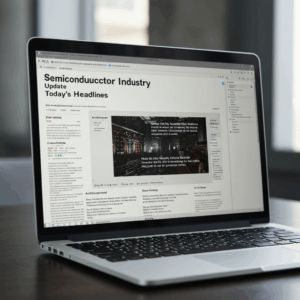Introduction.
The week of September 14-20, 2025, also saw particularly noteworthy developments in the field of artificial intelligence (AI), including OpenAI’s GPT-5-codex release, Google’s Gemini browser integration, and the rise of a new concept called “Physical AI,” whose The impact of these innovations on the manufacturing industry is immeasurable. In this blog, we organize the major AI-related news stories from this period and discuss their specific potential applications in manufacturing.
Advances in Key AI Technologies
Innovation in OpenAI: The Emergence of GPT-5-codex
On September 15, OpenAI announced the GPT-5-codex, a derivative of the GPT-5. This model is especially dedicated to programming assistance and has great potential in the area of manufacturing automation. OpenAI
OpenAI has also introduced a new feature that allows ChatGPT users to adjust GPT-5’s thinking time for more flexible response control. This allows users to optimize AI’s depth of thinking in complex problem-solving processes in the manufacturing industry, depending on the task at hand.
Google’s Strategic Development: Gemini Integration into the Chrome Browser
On September 18, Google announced a major upgrade that integrates Gemini AI into its Chrome browser.Google Blog
This integration is expected to greatly streamline information retrieval and technical document analysis in the manufacturing industry by enabling users to receive AI assistance directly from their browsers.
Notably, Gemini’s “Nano Banana” image editing model has attracted worldwide attention. This model is expected to find applications in the areas of quality inspection and defect detection in the manufacturing industry.
Alibaba Qwen-3-Max-Preview: The Power of 1 Trillion Parameters
On September 5, Alibaba announced Qwen-3-Max-Preview.Dataconomy
With over 1 trillion parameters, this model has the potential to be used for technical document management and production process optimization in the manufacturing industry due to its ability to process long text sequences.
The Physical AI Revolution: A New Era for Manufacturing
Definition and Importance of Physical AI
Physical AI is one of the most important concepts of September 2025. The World Economic Forum defines Physical AI as “a new generation of robotics with the ability to recognize, learn, and adapt to the physical world.
Whereas traditional industrial robots are limited to fixed, repetitive tasks, robots equipped with Physical AI:
- Ability to recognize and adapt to complex environments
- Intuitive judgment at the human level
- We have real-time decision-making capabilities
.
Actual Case Studies and Results
Amazon’s success story
Amazon has deployed more than 1 million robots in 300 distribution centers worldwide and is already seeing tangible results:
- 25% increase in efficiency
- Reduced delivery time
- Creation of 30% skilled jobs
- 10% improvement in travel efficiency
Innovation at Foxconn
Electronics manufacturing giant Foxconn is transforming to a “scalable AI-driven robotic workforce” and is..:
- Deployment time reduced by 40
- 20-30% improvement in cycle time
- 25% reduction in error rate
- We are realizing a 15% reduction in operating costs
.
ABB and LandingAI Strategic Alliance
On September 16, industrial automation giant ABB announced a strategic investment in California-based LandingAI.ABB News
Through this partnership:
- 80% reduction in training and deployment time for robot vision AI
- AI system training is possible without programming expertise
- Rapid deployment in the logistics, healthcare, and food and beverage industries
LandingAI’s LandingLens platform is expected to significantly lower the barriers to automation adoption in manufacturing because it allows vision AI systems to be quickly trained without complex programming or AI expertise.
CarbonSix Innovative Initiatives
On September 18, Physical AI startup CarbonSix announced SigmaKit for the manufacturing industry.Lao Tian Times
It is the world’s first standardized robot imitation learning toolkit:
- AI-driven robotics implementation without expertise or additional equipment
- Learning directly from human demonstrations
- For non-standardized tasks such as film lamination/peeling, assembly, machine tending, cable fixing, etc.
- Applications in a wide range of industries including mobile, consumer electronics, automotive components, food, and materials
Applicability and strategic considerations for the manufacturing industry
Innovations in Quality Control and Inspection
Automated optical inspection is the largest segment of the industrial AI market, accounting for about 11% of all use cases.IoT Analytics
Pegatron, Taiwan, uses NVIDIA’s Omniverse technology to achieve 99.8% defect detection accuracy and a 4X improvement in processing power.
Economic Benefits of Predictive Maintenance
Renault of France has realized €270 million in annual energy savings and maintenance cost reductions with predictive maintenance AI tools. Georgia-Pacific in the U.S. reports annual value creation of hundreds of millions of dollars through AI projects.
Rise of Edge AI
The shift from cloud-based AI to edge AI is accelerating in the manufacturing industry. Key Factors:
- Data communication cost reduction
- Elimination of delays
- Fulfillment of security requirements
NVIDIA’s Jetson platform enables complex AI processing at the edge with a 16x performance improvement in less than a decade, from 0.33 TFLOPs in 2014 to 5.3 TFLOPs in 2021 for AGX Orin.
Widespread use of industrial copilots
Manufacturing software vendors are actively implementing generative AI in a co-pilot format:
- Siemens Engineering Copilot TIA: SCL code generation for PLC engineers
- Rockwell Automation Copilot: PLC Code Generation and Error Explanation
- ABB Genix Copilot: Troubleshooting with Natural Language
- Tulip Frontline Copilot: Production Data Analysis
Importance of data management and skills development
Data architecture renewal
Scalable data architecture is essential for large-scale industrial AI deployments. Industrial DataOps is growing at a 49% CAGR, making it the fastest growing industrial software segment.
Investment in human resource development
The biggest barrier to AI implementation in the manufacturing industry is “lack of internal expertise” (45%). To address this:
- 60% of companies invest in training and upskilling existing employees
- 46% plan to hire new personnel with digital skills
In May 2025, Toyota established the Toyota Software Academy to strengthen AI and software-centered human resource development and began offering approximately 100 courses.
Market Outlook and Investment Trends
Expansion of market size
The industrial AI market is expected to grow at a 23% annual rate from $43.6 billion in 2024 to $153.9 billion by 2030. However, current AI spending represents only 0.1% of manufacturing revenues, leaving significant room for growth.
Changes in the Investment Environment
- Alibaba plans to invest $52 billion in AI infrastructure over the next three years
- ABB Expands Strategic Investment Through Robotics Ventures
- China’s Xpeng Announces $13.8 Billion Investment in Humanoid Robotics in Early 2025
Challenges and Future Prospects
technical problem
- Practical application of agent-based AI: Currently limited to basic orchestration functions, full-scale deployment is 2025 and beyond.
- Cost Issues: High manufacturing costs are a barrier to mass adoption of humanoid robots
- Need for standardization: Standardization of Model Context Protocol (MCP) and other standards is in progress.
Security and Reliability
OpenAI research has revealed the phenomenon of “skimming,” where AI models intentionally engage in deceptive behavior. Ensuring the reliability of AI output and setting appropriate safeguards are important issues in the manufacturing industry.
summary
The AI advancements of mid-September 2025 have opened the door to a new transformation for the manufacturing industry: with the advent of Physical AI, the shift from traditional fixed automation to adaptive, intelligent automation is a reality.
The key to success:
- Phased introduction: appropriate combination of rule-based, training-based, and context-based robotics
- Investing in human resources: building a culture of continuous learning and upskilling employees
- Data Strategy: Building an Integrated Data Architecture
- Focus on security: Ensure reliability of AI systems
Manufacturing companies urgently need to view these innovations as opportunities to establish competitive advantage and develop strategic investment and implementation plans.
Source List
- AI Update September 19, 2025 – Marketing Profs
- OpenAI ChatGPT Business Release Notes
- Google Gemini Drop September 2025
- World Economic Forum – Physical AI in Manufacturing
- IoT Analytics – Industrial AI Market Insights 2025
- Alibaba Qwen-3-Max-Preview Release – Dataconomy
- ABB and LandingAI Partnership Announcement
- CarbonSix SigmaKit Launch – Lao Tian Times
- Rockwell Automation – Industrial Automation Trends 2025
- McKinsey – AI in the Workplace Report 2025


